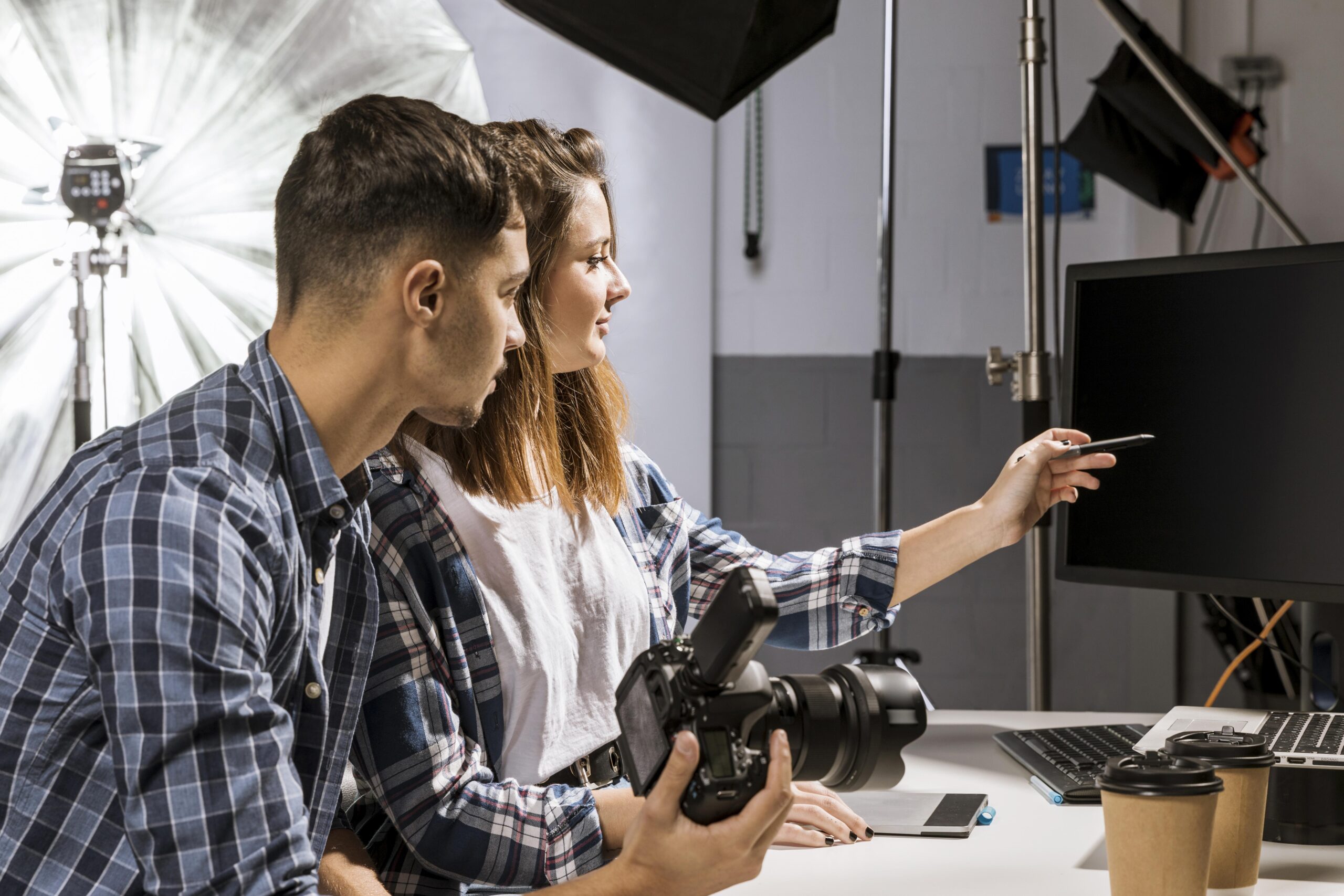
In today’s digital age, video content reigns supreme across social media platforms, websites, and even personal blogs. Whether you’re a budding vlogger, an aspiring filmmaker, or a small business owner looking to promote your brand, creating high-quality videos can seem daunting, especially if you’re on a tight budget. However, with the right techniques and tools, producing professional-looking videos doesn’t have to break the bank.
How to Create High-Quality Videos on a Budget
Here are some essential tips for beginners on how to create impressive videos without spending a fortune.
- Plan Your Video Content: Before diving into the production process, take the time to brainstorm ideas and plan out your video content. Define your goals, target audience, and key messages. Create a storyboard or outline to organize your thoughts and ensure a coherent narrative flow.
I Define Your Objectives:
- Identify Purpose: Determine the primary goal of your video.
- Set Clear Objectives: Establish specific, measurable objectives that you hope to achieve with your video. Whether it’s increasing brand awareness, driving website traffic, or generating leads, clarity in objectives will guide your content creation process.
II. Know Your Target Audience:
- Audience Research: Conduct thorough research to understand your target audience’s demographics, interests, preferences, and pain points.
- Create Audience Personas: Develop detailed profiles representing different segments of your target audience. This helps in tailoring your content to resonate with specific audience segments effectively.
III. Determine Key Messages:
- Identify Core Messages: Define the key messages you want to convey through your video. These should align with your objectives and cater to the needs and interests of your target audience.
- Craft Compelling Storylines: Develop engaging narratives or storylines that effectively communicate your key messages in a captivating manner.
- Invest in Quality Audio: While it’s tempting to focus solely on video quality, don’t underestimate the importance of audio. Viewers are more forgiving of mediocre visuals than they are of poor sound quality. Invest in a decent microphone, such as a lavalier or shotgun mic, to capture clear audio without breaking the bank.
I. Selecting the Right Microphone:
- Lavalier Microphones: These are small, clip-on microphones that attach to the speaker’s clothing, making them ideal for capturing clear, close-up audio in interviews, presentations, or vlogs.
- Shotgun Microphones: Shotgun mics are highly directional, capturing sound from a specific direction while minimizing background noise. They’re commonly used for outdoor filming, documentaries, and capturing dialogue in controlled environments.
II. Understanding Recording Environments:
- Controlled Environment: Choose a quiet, controlled environment for recording audio to minimize background noise and distractions. Opt for rooms with minimal echo or reverberation to achieve cleaner audio recordings.
- Outdoor Filming: When filming outdoors, be mindful of environmental factors such as wind, traffic noise, and other ambient sounds. Consider using windshields or furry covers for your microphones to reduce wind noise.
- Use Natural Lighting: Lighting can make or break your video quality, but you don’t need expensive studio lights to achieve professional results. Whenever possible, utilize natural light sources like windows to illuminate your scenes. Position yourself or your subject facing the light source for flattering, evenly-lit shots.
II. Choosing the Right Location:
- Indoor Locations: Position your subject near windows or doors to take advantage of natural light streaming into the room. Choose rooms with large windows and white or light-colored walls to maximize light diffusion and minimize harsh shadows.
- Outdoor Locations: Opt for shaded areas or open spaces with indirect sunlight to avoid harsh shadows and overexposure. Consider the time of day and weather conditions to ensure optimal lighting conditions for filming.
III. Modifying Natural Light:
- Diffusion: Use sheer curtains, diffusers, or translucent materials to soften harsh sunlight and create a more flattering, diffused lighting effect. This helps minimize harsh shadows and evens out the overall illumination.
- Reflectors: Utilize reflectors, such as white foam boards or reflector discs, to bounce natural light onto your subject and fill in shadows. Position reflectors opposite the light source to redirect and amplify light as needed.
- Optimize Your Shooting Environment: Pay attention to your filming location and surroundings. Choose a quiet, clutter-free space with minimal distractions. Consider using props, backdrops, or simple DIY setups to enhance visual appeal without spending a fortune on elaborate sets.
I. Choose the Right Location:
- Indoor Settings: Select a spacious, well-lit room with minimal background noise and distractions. Consider factors such as ceiling height, wall color, and natural light sources when choosing your filming location.
- Outdoor Settings: If filming outdoors, scout locations with visually appealing backgrounds, ample natural light, and minimal noise pollution. Pay attention to weather conditions and time of day to ensure optimal lighting conditions.
II. Set Design and Props:
- Props and Set Dressing: Choose props, furniture, and decorations that complement your video’s theme or narrative. Keep the set design simple and uncluttered to avoid distracting viewers from the main subject.
- Background Elements: Consider adding visual interest to your background with plants, artwork, or textured backdrops. Ensure that background elements enhance rather than detract from the overall composition of your shots.
- Master Basic Camera Techniques: You don’t need a top-of-the-line camera to create impressive videos. Even a smartphone or entry-level DSLR can produce high-quality footage with the right techniques. Learn the basics of framing, composition, and camera settings to capture engaging shots that hold viewers’ attention.
I. Framing and Composition:
- Leading Lines: Use leading lines, such as roads, fences, or architectural elements, to draw the viewer’s eye towards the main subject or focal point of your shot.
II. Camera Settings:
- Exposure: Adjust exposure settings, including aperture, shutter speed, and ISO, to achieve proper exposure in various lighting conditions. Use a wide aperture for shallow depth of field and a blurred background, adjust shutter speed to control motion blur, and set ISO to maintain image quality in low-light situations.
- White Balance: Set white balance to ensure accurate color reproduction in your footage. Choose preset white balance settings or manually adjust white balance based on the lighting conditions of your shooting environment.
- Edit Like a Pro: Post-production is where your raw footage transforms into a polished final product. Invest time in learning basic video editing techniques using affordable or even free editing software like Adobe Premiere Rush, DaVinci Resolve, or iMovie. Trim unnecessary footage, add transitions, overlays, and music to enhance your video’s visual appeal.
I. Familiarize Yourself with Editing Software:
- Choose the Right Software: Select a professional video editing software that suits your needs and skill level.
- Learn the Interface: Familiarize yourself with the layout, tools, and features of your chosen editing software. Explore tutorials, user guides, and online resources to gain proficiency in navigating the interface and accessing essential functions.
II. Organize Your Footage:
- Import Footage: Import your video clips, audio files, and other media assets into your editing software. Organize your media files into folders or bins to streamline the editing process and facilitate easy access to content.
- Label and Tag Clips: Use descriptive labels, tags, or markers to identify key moments, scenes, or shots within your footage. This makes it easier to locate specific clips and streamline the editing workflow.
- Utilize Free Resources: Take advantage of free online resources and tutorials to expand your knowledge and skills in video production. Platforms like YouTube, Vimeo, and online forums offer a wealth of educational content on filming techniques, editing tricks, and equipment reviews.
I. Royalty-Free Music and Sound Effects:
- Websites: Explore websites offering royalty-free music and sound effects, such as YouTube Audio Library, Free Music Archive, and SoundCloud. These platforms offer a vast library of music tracks and sound effects that you can use in your videos free of charge.
- Attribution: Pay attention to licensing terms and attribution requirements when using royalty-free music and sound effects. Some tracks may require you to credit the artist or provide attribution in your video description.
II. Video Editing Software:
- Free Software: Utilize free video editing software options such as DaVinci Resolve, Shotcut, and OpenShot. These platforms offer powerful editing tools and features comparable to premium software, allowing you to edit and enhance your videos without spending a dime.
- Promote Your Videos Strategically: Once you’ve created your masterpiece, don’t let it gather dust on your hard drive. Strategically promote your videos across social media channels, blogs, and relevant online communities to reach your target audience. Engage with viewers, respond to comments, and solicit feedback to continually improve your content.
I. Identify Your Target Audience:
- Audience Persona: Define your target audience based on demographics, interests, preferences, and behaviors. Understand their needs, pain points, and interests to tailor your promotion efforts effectively.
- Audience Segmentation: Segment your audience into distinct groups based on factors such as age, gender, location, and interests. Customize your promotion strategies and messaging to resonate with each audience segment.
II. Optimize Video Metadata and Thumbnails:
- Title and Description: Create compelling titles and descriptions that capture viewers’ attention and accurately describe the content of your video. Incorporate relevant keywords and phrases to improve search visibility and discoverability.
- Thumbnail Design: Design eye-catching thumbnails that entice viewers to click on your video. Use high-quality images, bold text, and contrasting colors to create visually appealing thumbnails that stand out in search results and recommended videos.
By following these tips and techniques, even beginners can produce high-quality videos that captivate audiences without breaking the bank. Remember, the key to success lies in creativity, resourcefulness, and a willingness to learn and experiment. So grab your camera, unleash your imagination, and start creating compelling video content today!




